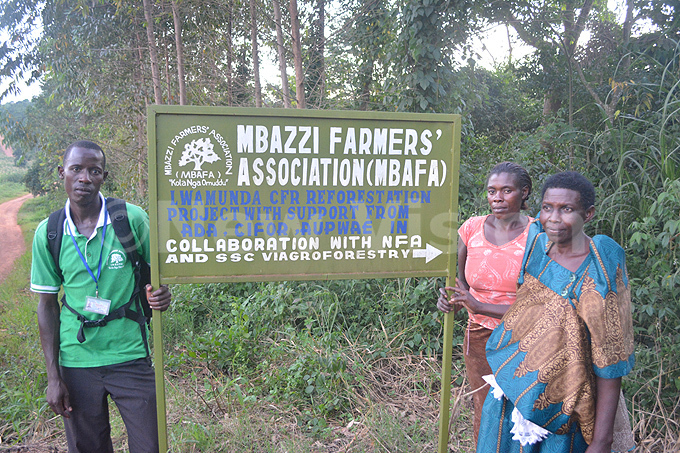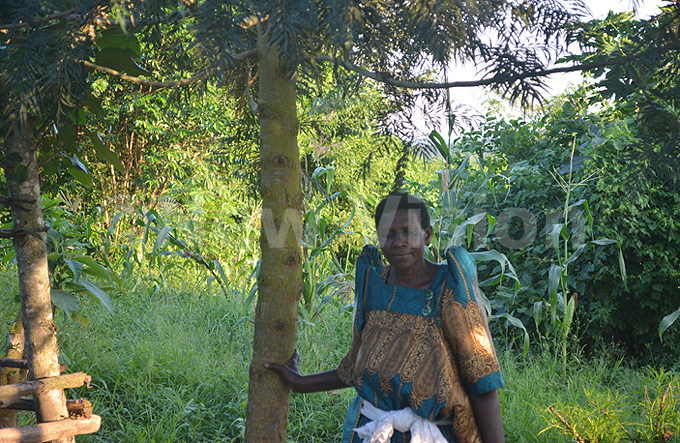Women's group restores "Great Green Wall"
They spend less time doing gainful work because they have to walk long distances in the search of firewood and water.
What does it mean for a rural woman to go without firewood and water? For Teopista Nakamya, a resident of Mbazzi village in Muduuma Sub County along Mityana Road, the scarcity of water and firewood increases the burden on women.
They spend less time doing gainful work because they have to walk long distances in the search of firewood and water.
Not far from her residence is the 694 hectare-Lwamunda forest reserve which was like the Biblical Garden of Eden about two decades ago. It was a source of free firewood, water, honey and herbs that were harvested to treat different ailments.
As the demand for timber and fuel for cooking increased in Kampala, the dealers supplying such raw materials turned to Lwamunda. They stripped the forest of the large trees to cut the needed timber for construction, and the smaller trees for charcoal and firewood for cooking. Others established farmland in the reserve and led the forest to total destruction.

"It was a case of biting the hand that had freely nurtured us," said Nakamya, adding that the bountiful source of firewood and water dried up.
In an effort to restore the forest, the Forestry Department which was replaced by the National Forestry Authority (NFA) in 2004, started courting private tree farmers to restore the forest. NFA attracted the private sector into the forest because it has capital to promote investment in planting the trees.
But this ended up displacing the women and the men who had always depended on the forest for survival. "We were seen as trespassers by the new comers who got permits and planted trees in the forest," said Nakamya, adding that it was no longer possible for them to gather firewood in the forest for cooking food.
As for the men, therewere no more trees to provide commercial products including timber, poles and charcoal. "The people who were given permits to plant trees in Lwamunda come from outside the community and hire guards to keep their trees," said George William Kibalama, the Publicity Secretary of Mbazzi Farmers Association (MBAFA).
This was a wake-up call for the local community to plant their own trees from which they could harvest products such as firewood and timber. They organised themselves into a group known as MBAFA in order to restore the forest and also improve their standard of living.

So when the Association of Uganda Professional Women in Agriculture and Environment (AUPWAE)raised concerns about the women who were being left out of tree planting yet they were the most affected, helped to link MBAFA to other development agencies such as VI Agroforestry, Mpigi District Local Government and NFA.
AUPWAE with her concerns about women, in Partnership with The school of forestry of Makerere University and Center for International Forest Research (CIFOR) funded by Austrian Development Agency (ADA) came in with the Adaptive Collaborative Management Approach which empowers communities to plan, implement and monitor and evaluate for themselves.
As much as the investors were the winners in occupying the land for planting trees, the losers who included the local women and men were going to be a threat to the sustainable use of Lwamunda forest reserve, according to Concepta Mukasa, programme officer at AUPWAE.
"You cannot lock thousands of starving people from a granary," she said, adding that it was important to empower the communities and also provide access to the local people to plant trees.
Unlike most initiatives that thrive on giving communities money to plant trees, AUPWAE opted to provide skills and also linked to local Government, Central Government and NGOs including VI Agro-forestry.
The first partnership they created was with the NFA where they were given 25 acres to replant in the forest under Collaborative Forest Management. They established a nursery of indigenous trees which they planted in part of the 25 acres of trees NFA permitted them to use. Others were planted agro-forestrytrees species on their land outside the forest and along the edges of their gardens and land.
Every member of Mbazzi both women and men were allocated at least half an acre to generate firewood. Presently almost all members including women in the six groups at least own trees either on their farms or in central forest reserves.
"The land which was allocated to the group in the forest was shared equally among all members (men and women) and even the seedlings from the nursery were distributed equally to all members," according to Mukasa.
As they planted the trees, the group membership shrunk from 100 in 2001 to the current 42, according to Kibalama. He pointed out that the reason behind this was that tree planting is a long term venture and most people wanted quick results. "We faced realities of life and got good lessons," he said.
He says the group discovered that a loan and savings scheme would help them to pool resources which they could use to address immediate problems and also provide a source of money to invest in different enterprises.
As a result, the group members have created alternative means of generating income ranging from poultry, rearing bees, growing mushrooms, passion fruits and fish farming.
"We have managed to keep our children in school and life has improved," said Betty Nakityo, a resident and member of Mbazzi group.
Putting forests in the hands of the local people has helped to increase participation and promote sustainable use of Lwamunda forest. "People are planting trees for their own use and because they suffered the effects of environmental disasters they have come out to protect it," said Levi Etodu, the director in charge of natural forests at NFA.
As we moved through the forest, a group of members led by Kibalama said the indigenous trees are coming back as well as wild animals such as monkeys, antelopes and birds.
At Nakamya's place, there is a garden of tomatoes, onions and a leafy garden of bananas with vegetables that help to provide her children and visitors with a rich diet. She also harvests water which is kept in a huge underground tank. The rooftop also has solar panels for harvesting solar and also solar box for boiling water. Her kitchen has an energy saving cooking place to reduce on the waste of firewood.
This, according to Nakamya is repeated many times in the village and the neighbouring villages around Muduma. It is a model, which should be replicated in areas neighbouring the forest reserves across the country in order to protect the forests and improve the livelihoods of the local communities.